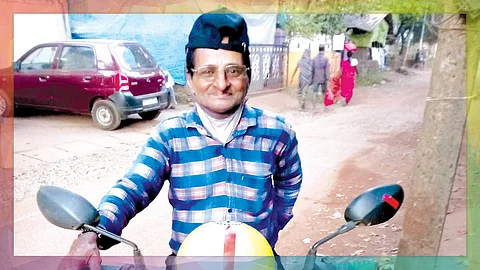

ERWIN FONSECA
ASSAGAO: Goa’s public transport system was once skeletal, and owning a family vehicle was a significant achievement. Despite its reputation as a tourist destination, tourism in the old days was far less intense. It was during this period that many Goan youth took up work as motorcycle pilots, ferrying people for only a few rupees. This role was considered a noble profession, even though earnings were often meagre. Many of those early pioneers have since passed away or retired, but one who remains steadfast is 65-year-old Vijay Raghunath Pawaskar from Assagao, who has worked as a motorcycle pilot for nearly 45 years.
Vijay grew up in the quiet village of Assagao. He attended a local Marathi school until Class VIII, but financial difficulties forced him to leave school and earn money to support his family. “Ours was a very poor family, living hand to mouth during my childhood. My parents encouraged me to get a basic education, but by age 12, I had to quit school,” he recalls.
In those days, finding work was easier, as communities were more supportive, and Vijay took on several menial jobs. He worked in small hotels and as a conductor on the Mapusa-Assagao bus — the only bus serving the route — and later as a conductor on Mapusa-Margao buses, when a ticket cost just Rs 2.50. He did this work for nearly eight years before finally getting his motorcycle licence at age 20, which set him on his path to becoming a motorcycle pilot.
“At the time, motorcycle pilots were well-regarded. They were seen as saviours, and the profession was respected, even though the earnings were modest. That’s why I chose this path,” Vijay says.
But starting as a pilot wasn’t easy for Vijay. “I had no money to buy my own bike, so I would rent motorcycles from friends, paying them Rs 50 per day. Many of them were kind enough to let me use their bikes for days at a time. After saving up, I finally bought my first Rajdoot motorbike in 1985 for Rs 3,500 — a big sum back then. It felt like a dream come true, ferrying passengers on my own bike.”
When the new Mapusa bus stand opened in the early 1980’s, it became a hub for taxis and motorcycle pilots, and Vijay has worked at this spot ever since. “It has been a wonderful experience over the last 45 years serving people. Earlier, fares were low because the cost of living was low — we’d charge a rupee or two for short distances. Today, even a short trip costs around Rs 100 due to rising costs,” he explains.
Over the years, Vijay has supported his family through his work as a pilot and raised his children. He has owned 11 motorcycles in his career, with his current one being 13 years old, bought for around Rs 70,000. “Today, such bikes cost over a lakh, and many pilots have to take loans to afford them,” he adds. Assagao once had around 10 motorcycle pilots of Vijay’s age; now, only two or three juniors remain, with Vijay being the last of his age group still active. He hopes to work another five years to complete 50 years in the profession, saying, “It depends on the Almighty and the good wishes of my customers, whom I always serve with a smile. God has blessed me thus far, and I believe He will continue to do so. I am also grateful to my family for their support.”
When asked about the future of motorcycle pilots in Goa, Vijay laments the influence of politics and competition from out-of-towners. “Vote-bank politics has changed Goa’s ethos. Today, non-Goans are entering every field, including ours. It’s difficult to predict the future of this occupation, but Goan pilots will always stand out for being generous and helpful to fellow Goans,” he concludes.